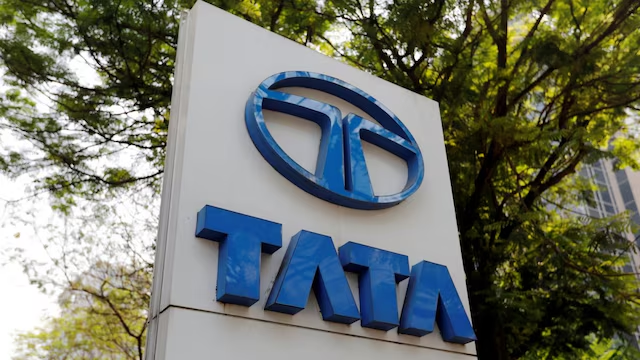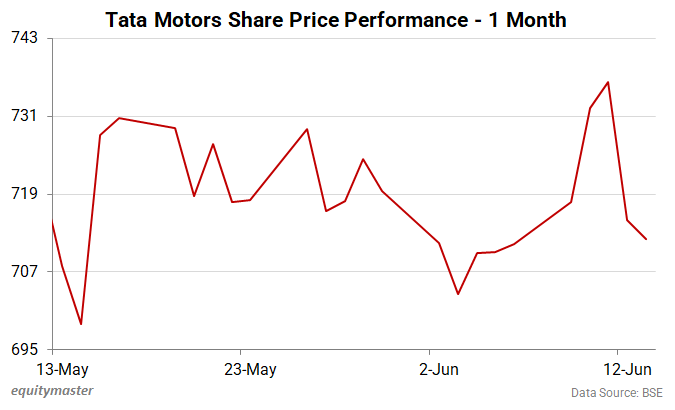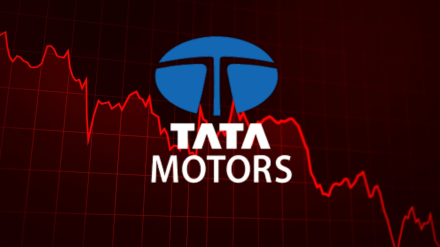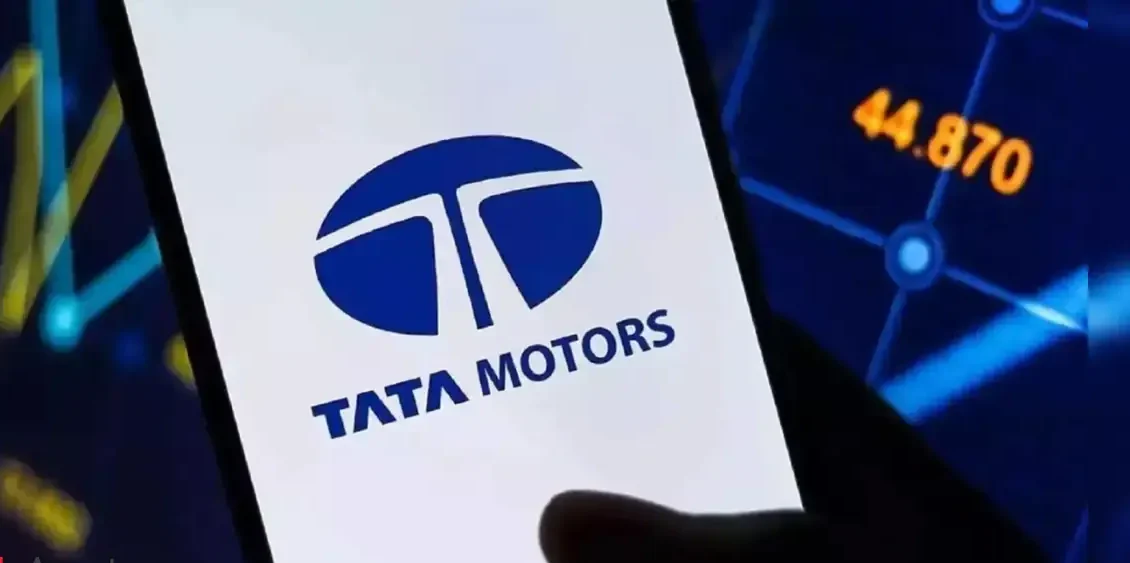Tata Motors faces challenges as its UK-based luxury arm, Jaguar Land Rover (JLR), slashed its FY26 EBIT margin forecast from 10% to 5-7%. On June 16, 2025, this news triggered a 5% drop in Tata Motors’ shares, hitting a one-month low of ₹672.95 on the National Stock Exchange. New US tariffs on foreign-made vehicles, coupled with demand weakness in Europe and China, have clouded JLR’s outlook. Despite this, Moody’s recently affirmed Tata Motors’ Ba1 rating and upgraded JLR’s outlook, offering some optimism. Let’s explore the factors behind this turbulence, JLR’s strategic response, and Tata Motors’ path forward.
Why Tata Motors’ Shares Plummeted
On June 16, 2025, Tata Motors’ shares dropped sharply. The decline reached as much as 5.5%, hitting a one-month low of ₹672.95 on the National Stock Exchange. The primary trigger was JLR’s revised FY26 earnings before interest and taxes (EBIT) margin forecast. Previously set at 10%, JLR now expects margins between 5% and 7%. This is a significant drop from the 8.5% reported in FY25. Additionally, JLR projected free cash flow to be “close to zero” in FY26, down from £1.5 billion in FY24-25. These announcements sparked investor concerns about profitability and cash generation. The global automotive industry’s uncertainty, particularly due to new US tariffs, further fueled the decline.
Moreover, JLR’s lack of manufacturing facilities in the US exacerbates the issue. The new 25% tariff on foreign-made vehicles directly impacts JLR’s cost structure. Unlike competitors like Mercedes-Benz and BMW, which have US-based plants, JLR relies heavily on imports. For instance, its popular Defender SUV is manufactured in Slovakia, making it subject to these tariffs. This vulnerability makes Tata Motors one of the most exposed Indian automakers to US trade policies.

US Tariffs and Their Impact on JLR
The US, under recent policy changes, imposed a 25% tariff on all foreign-made vehicles. This significantly affects JLR, as the US is a key market for its luxury vehicles. While JLR’s Range Rover line is produced in the UK, the Defender SUV’s production in Slovakia leaves it exposed to these tariffs. To mitigate this, JLR is exploring pricing strategies. Analysts suggest JLR’s wealthier customer base may absorb higher prices. However, this approach risks losing market share to competitors with US manufacturing bases.
Furthermore, JLR is reallocating vehicle units to more accessible markets. This strategy aims to offset the tariff impact. Yet, the company faces additional challenges. Demand weakness in Europe and China, coupled with tariff-led uncertainties, adds pressure. JLR’s FY26 outlook reflects these global headwinds. The company also anticipates higher capital expenditure for its electrification push, further straining margins.
Moody’s Ratings: A Positive Note
Despite the gloomy outlook, Moody’s Ratings offered some optimism. On June 13, 2025, they affirmed Tata Motors’ Ba1 corporate family rating with a positive outlook. Additionally, they upgraded JLR’s rating from Ba2 to Ba1. This reflects JLR’s improving credit profile and strategic importance to Tata Motors. Moody’s highlighted Tata Motors’ debt reduction and earnings growth. JLR, contributing 71% of Tata Motors’ revenue and 80% of its profitability in FY25, remains a cornerstone of the company’s success.
The rating upgrade underscores JLR’s electrification efforts. The company is investing heavily in electric vehicles (EVs). It plans to launch the Range Rover Electric in late 2025 and an all-electric Jaguar GT in 2026. These moves align with JLR’s goal to become an electric-only brand by 2030. Moody’s also noted Tata Motors’ demerger plans, which could see JLR contributing over 90% of EBITDA post-demerger. This strategic restructuring enhances Tata Motors’ financial stability.

JLR’s Strategic Response to Challenges
JLR is not sitting idle. The company outlined enterprise missions targeting £1.4 billion in annual value, excluding tariff effects. These focus on emissions compliance, cost controls, and digital transformation. JLR’s four-brand strategy—Range Rover, Defender, Discovery, and Jaguar—remains central to its premium positioning. The company is also converting its Halewood plant for EV production, signaling a strong commitment to electrification.
Additionally, JLR is navigating a year of model changeovers. The transition to electric vehicles requires significant investment. This, combined with tariff pressures, explains the lowered FY26 forecast. However, JLR remains confident in its long-term targets. Analysts believe the company’s strategic direction is sound, despite short-term challenges. The focus on high-performance EVs, like the Jaguar GT priced above £100,000, aims to maintain JLR’s luxury market dominance.
Tata Motors’ Broader Strategy
Beyond JLR, Tata Motors is focusing on its domestic operations. At its June 9, 2025, investor day, the company outlined plans for its commercial vehicle (CV) and passenger vehicle (PV) segments. It expects single-digit growth in both segments for FY26. In the PV segment, Tata Motors aims for a 16% market share by FY27, with plans to launch seven new products by FY30. These include the Sierra, Avinya range, and new internal combustion engine and EV models.
However, challenges persist. The CV segment faces margin pressure due to a safeguard duty on steel. Slower EV sales and an aging portfolio may hinder PV growth. Nevertheless, Tata Motors is banking on its compressed natural gas (CNG) segment and new product refreshes to drive growth. The company targets a double-digit EBITDA margin in PVs by FY27, reflecting its ambitious plans.

What Lies Ahead for Tata Motors
Looking forward, Tata Motors faces a complex landscape. JLR’s lowered FY26 forecast and tariff challenges pose near-term risks. The company’s heavy reliance on JLR—contributing 71% of revenue—makes it vulnerable to global market shifts. Yet, JLR’s electrification push and Tata Motors’ domestic growth strategies offer hope. The successful launch of the Range Rover Electric and Jaguar GT could bolster JLR’s position in the luxury EV market.
Analysts remain cautious. Nuvama Institutional Equities issued a “REDUCE” rating with a target price of ₹670, citing subdued CV growth and JLR’s challenges in the US, Europe, and China. However, Moody’s positive outlook and JLR’s rating upgrade signal long-term potential. Investors should monitor JLR’s pricing strategies and EV rollout progress. Tata Motors’ ability to navigate tariffs and execute its electrification plans will be critical.
Key Takeaways
Tata Motors is at a crossroads. The recent stock decline reflects JLR’s cautious FY26 outlook, driven by US tariffs and global uncertainties. However, the company’s strategic focus on electrification and cost management offers a path forward. Moody’s ratings affirm Tata Motors’ resilience, while JLR’s premium positioning remains a key strength. As the automotive industry evolves, Tata Motors’ ability to adapt will determine its future success. Investors and stakeholders should stay tuned for updates on JLR’s EV launches and Tata Motors’ domestic growth initiatives.

